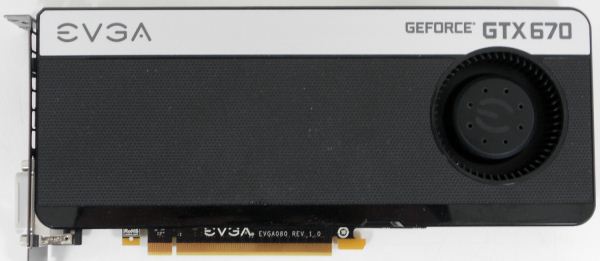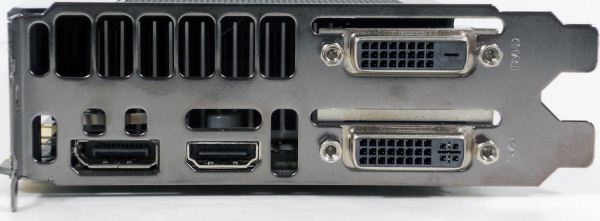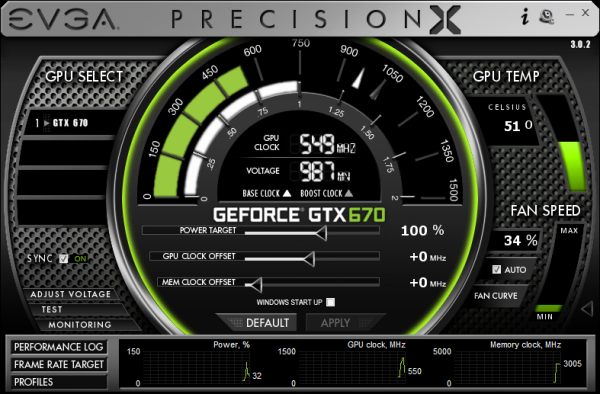NVIDIA GeForce GTX 670 Review Feat. EVGA: Bringing GK104 Down To $400
by Ryan Smith on May 10, 2012 9:00 AM ESTMeet The EVGA GeForce GTX 670 Superclocked
Our second card of the day is EVGA’s GeForce GTX 670 Superclocked, which in EVGA’s hierarchy is their first tier of factory overclocked cards. EVGA is binning GTX 670s and in turn promoting some of them to this tier, which means the GTX 670 Superclocked are equipped with generally better performing chips than the average reference card.
| GeForce GTX 670 Partner Card Specification Comparison | ||||
| EVGA GeForce GTX 670 Superclocked | GeForce GTX 670 (Ref) | |||
| CUDA Cores | 1344 | 1344 | ||
| Texture Units | 112 | 112 | ||
| ROPs | 32 | 32 | ||
| Base Clock | 967MHz | 915MHz | ||
| Boost Clock | 1046MHz | 980MHz | ||
| Memory Clock | 6210MHz | 6008MHz | ||
| Memory Bus Width | 256-bit | 256-bit | ||
| Frame Buffer | 2GB | 2GB | ||
| TDP | 170W | 170W | ||
| Manufacturing Process | TSMC 28nm | TSMC 28nm | ||
| Width | Double Slot | Double Slot | ||
| Length | 9.5" | 9.5" | ||
| Warranty | 3 Years | N/A | ||
| Price Point | $419 | $399 | ||
For the GTX 670 SC, EVGA has given both the core clock and memory clock a moderate boost. The core clock has been increased by 52MHz (6%) to 967MHz base and 66MHz (7%) boost to 1046MHz. Meanwhile the memory clock has been increased by 202MHz (3%) to 6210MHz.
Other than the clockspeed changes, the GTX 670 SC is an almost-reference card utilizing a reference PCB with a slightly modified cooler. EVGA is fabricating their own shroud, but they’ve copied NVIDIA’s reference shroud down to almost the last detail. The only functional difference is that the diameter of the fan intake is about 5mm less, otherwise the only difference is that EVGA has detailed it differently than NVIDIA and used some rounded corners in place of square corners.
The only other change you’ll notice is that EVGA is using their own high flow bracket in place of NVIDIA’s bracket. The high flow bracket cuts away as much metal as possible, maximizing the area of the vents. Though based on our power and temperature readings, this doesn’t seem to have notably impacted the GTX 670 SC.
While we’re on the matter of customized cards and factory overclocks, it’s worth reiterating NVIDIA’s position on factory overclocked cards. Reference and semi-custom cards (that is, cards using the reference PCB) must adhere to NVIDIA’s power target limits. For GTX 670 this is a 141W power target, with a maximum power target of 122% (170W). Fully custom cards with better power delivery circuitry can go higher, but not semi-custom cards. As a result the flexibility in building semi-custom cards comes down to binning. EVGA can bin better chips and use them in cards such as the Superclocked – such as our sample which can go 17 boost bins over the base clock versus 13 bins for our reference GTX 670 – but at the end of the day for stock performance they’re at the mercy of what can be accomplished within 141W/170W.
In any case, as the card is otherwise a reference GTX 670 EVGA is relying on the combination of their factory overclock, their toolset, and their strong reputation for support to carry the card. EVGA has priced the card at $419, $20 over the GTX 670 MSRP, in-line with other factory overclocked cards.
On the subject of pricing and warranties, since this is the first EVGA card we’ve reviewed since April 1st, this is a good time to go over the recent warranty changes EVGA has made.
Starting April 1st, EVGA has implemented what they’re calling their new Global Warranty Policy. Starting July 1st, 2011 (the policy is being backdated), all new EVGA cards ship with at least a 3 year warranty. And for the GTX 600 series specifically, so far EVGA has only offered models with a 3 year warranty in North America, which simplifies their product lineup.
To complement the 3 year warranty and replace the lack of longer term warranties, EVGA is now directly selling 2 and 7 year warranty extensions, for a total of 5 and 10 years respectively. So instead of buying a card with a 3 year warranty or a longer warranty, you’ll simply buy the 3 year card and then buy a warranty extension to go with it. However the extended warranty requires that the card be registered and the warranty purchased within 30 days.
The second change is that the base 3 year warranty no longer requires product registration. EVGA has other ways to entice buyers into registering, but they’ll now honor all applicable cards for 3 years regardless of the registration status. At the same time the base 3 year warranty is now a per-product warranty (e.g. a transferable warranty) rather than per-user warranty, so the base warranty will transfer to 2nd hand buyers. The extended warranties however will not.
The third change is how EVGA is actually going to handle the warranty process. First and foremost, EVGA is now allowing cards to be sent to the nearest EVGA RMA office rather than the office for the region the card was purchased from. For example a buyer moving from Europe to North America can send the card to EVGA’s North American offices rather than sending it overseas.
Finally, EVGA is now doing free cross shipping, alongside their existing Advanced RMA program. EVGA will now cross-ship replacement cards for free to buyers. The buyer meanwhile is responsible for paying to ship the faulty card back and putting up collateral on the new card until EVGA receives the old card.
There’s also one quick change to the step-up program that will impact some customers. With the move to purchasing extended warranties, the step-up program is only available to customers who either purchase an extended warranty or purchase an older generation card that comes with a lifetime warranty. Step-up is not available to cards with only the base 3 year warranty.
Moving on, along with EVGA’s new warranty EVGA is bundling the latest version of their GPU utilities, Precision X and OC Scanner X.
Precision X, as we touched upon quickly in our GTX 680 review, is the latest iteration of EVGA’s Precision overclocking & monitoring utility. It’s still based on RivaTuner and along with adding support for the GTX 600 series features (power targets, framerate caps, etc), it also introduces a new UI. Functionality wise it’s still at the top of the pack along with the similarly RivaTuner powered MSI Afterburner. Personally I’m not a fan of the new UI – circular UIs and sliders aren’t particularly easy to read – but it gets the job done.
OC Scanner X has also received a facelift and functionality upgrade of its own. Along with its basic FurMark-ish stress testing and error checking, it now also offers a basic CPU stress test and GPU benchmark.



















414 Comments
View All Comments
kingkazuma - Friday, May 11, 2012 - link
i was honestly surprised that Nvidia didn't make the 600 series more powerful in gpcomputingwell guess its 7970 for me... but i would want one of these for gaming :D
CeriseCogburn - Friday, May 11, 2012 - link
Gee what programs are you going to use the amd card for in compute ?I'd sure like to hear for once what amd can do, instead of experiencing it's massively frustrating failures and apologists and recent unbelievable hypocrits.
What the heck "compute" are you using a 7970 for - I'd sure like to know what programs... and what exactly stream is capable of, but all we ever get is a blank and some fat slow drooling talking point, except when it's pointed out that nVidia has ten thousand more drivers and support and software base in compute so it's the only way to go.
Would you enlighten us ?
CeriseCogburn - Sunday, May 13, 2012 - link
PS - the 7970 lost the computer benchmarks here, and the 680 won.I guess you never checked the results and just went with the "on paper !" fantasies.
Good luck squandering up valid programs and valid amd software.
At least you can use the now "we'll never do it !" "we are love, we are amd! " "we demand open source! " "we demand corporate responsibility !" - PROPRIETARY amd hacked openCL winzip.
Enjoy that gigantic hypocrisy unzipping.
Amd is for suckers.
james.jwb - Friday, May 11, 2012 - link
I normally like to read the comment section here, but honestly can't be bothered since certain trolls have come here and for the 10th time (in the last 2/3 years), get to run a riot for a few weeks until someone at Anandtech finally butts in and bans him.Yawn to this scenario once again.
Move to Disqus, Anandtech, and start moderating. You'll get 500 comments per important article and won't have to let controversy and trolls stay to bolster discussion.
Gastec - Tuesday, November 13, 2012 - link
I subscribe to that. If they don't take action maybe we should.CeriseCogburn - Friday, May 11, 2012 - link
Civ5 " On our final test the 7970 sees a slight resurgence compared to the past few games, preventing NVIDIA from sweeping the whole back half of our tests. "Well, actually, that's not nVidia sweeping "the whole back HALF" that's nVidia sweeping the entire last 75% or 3/4ths, and if it weren't for the TWS2 bug, amd could claim only 2 out of 10 games, losing a FULL 80%, more than 3/4ths of all gaming tests.
Instead of hearing the awful truth since the 7970 dives as resolution goes up losing miserably, which is ALWAYS pointed out when nVidia cards react that, puttting down some imaginary problem the reviewer guesses at concerning nVidia, instead we hear how amd shows a slight "resurgence" like a good terrorist card, and it's not noted it's only at the lowest resolution shown, of course.
Next the reviewer tells us how the 600 series doesn't do very well "against the 500 series" here - yet the 580 BEATS the 7950 at both 1920 and at 2560 - in other words, the truth is, the GTX500 series does EXCEPTIONALLY WELL here, smacking down even the "resurgent" amd cards brother.
The 570 is about 40% and then 30% ahead of the 6970, as another example of how well the 500 series plays this game. That's extended performance, not 600 series "interesting it's not far ahead".
Of course, IMO only an amd fanboy could come up with that kind of wording and analysis.
Was it so "interesting" that the reviewer couldn't see the 580 and 570 cleaning the clocks of their competition and even above their competition ?
So when the nVidia just prior tier does well, it's the current card not doing so well against it.
When the current nVidia cards do win 75% of the games against amd, it's belittled to less than half, with the special less than half "sweep" phrasing, with the 7970 amd flagship losing past the lowest tested resolution as the "catch".
What a bad joke for Nvidia the pro amd words are in these reviews games pages.
medi01 - Friday, May 11, 2012 - link
"7970 dives as resolution goes up losing miserably"Are you on a crack, or something?
CeriseCogburn - Friday, May 11, 2012 - link
Look at the civ5 page - Civilization 5 gaming page review, as soon as you put down your stupid dumb you down drug.medi01 - Saturday, May 12, 2012 - link
So what are you smoking? Is it crack that dumbs down and turns into zealont, or were you born an idiot?CeriseCogburn - Saturday, May 12, 2012 - link
Excellent rebuttal, you've made your point for amd so well.